This tactical analysis delves into İlkay Gündoğan’s differing roles at Manchester City, offers statistical comparisons between the midfielder, teammates and opposition players, in addition to tactical insights via visualisations. All data utilised in this piece is average per game data from all club competitions in the 18/19 season. Data filters were used to appraise players in specific positions.
Background
Despite being a decorated player in the Bundesliga and Premier League, Gündoğan is a player who has a tendency to fly somewhat under the radar at Manchester City, often overshadowed by his central midfield teammates. This is the German international’s third season at Manchester City, and arguably his best. His first two seasons in England were plagued with injury and a lack of starts, making just nine and 15 Premier League starts in the 16/17 and 17/18 seasons, respectively. This season he made 23 starts in the league during the treble-winning campaign. His versatility and impressive performances when playing ahead of Kevin De Bruyne and Fernandinho, who have both had their injury issues, have outlined his importance to Manchester City.
Where does he play?
If you ask most people which three players should start in midfield for Manchester City in their 4-3-3 formation, I’d wager that the majority would go for Fernandinho in the holding role, with David Silva and Kevin De Bruyne in more advanced positions to the left and right of the Brazilian. This has been reinforced by Pep Guardiola as the trio started the majority of matches together in the 17/18 campaign. So where does Gündogan fit in?
Throughout his time at Borussia Dortmund, Manchester City and with Germany, he has played in multiple midfield roles including the ‘6’, ‘8’ and ‘10’ positions, he has even been pushed up into a false ‘9’ position on occasion too. He is the “complete player,” Jürgen Klopp claimed when discussing the player at Borussia Dortmund, “he has the necessary calm, the eye and the vision. Gündoğan now sees bigger spaces and can also find them with long balls. He is strong on the ball while knowing when to make a tackle.” Such descriptions fit the notion of him being a versatile midfield operator, capable of contributing successfully in a number of roles. However, Guardiola stated Gündoğan is a “special player with a lot of personality,” but referred to him as an “attacking midfielder.” This suggested that Pep sees the German as an alternative option to David Silva and Kevin De Bruyne, along with Bernardo Silva and Phil Foden, as opposed to a defensive midfield alternative to Fernandinho.
Although Pep seemingly sees the German as an attacking midfielder, the lack of recruitment in the defensive midfield area for Manchester City over the summer of 2018, left Gündoğan as the most likely replacement for Fernandinho if injury or suspension occurred. The players do have differing playing styles, which will be investigated further on, but the alternatives in Fabian Delph and John Stones were needed to cover left back, centre back and had not played the number ‘6’ role as much as Gündoğan previously. City were reported to be very close to signing Jorginho, who interestingly has a style closer to that of Gündoğan as opposed to Fernandinho, but he chose to be reunited with Sarri at Chelsea. Rather than buy for the sake of it, Pep chose to trust in the squad he had for the 18/19 season, therefore, placing his trust in Gündoğan to fill offensive and defensive midfield roles when required.
Manchester City’s typical formation
As shown above, within the 4-3-3 system, Gündoğan is most suited to replacing one of the 3 midfielders. This may be Fernandinho in the defensive midfield number ‘6’ role, or David Silva or Kevin De Bruyne in the more attacking central midfield number ‘8’ role. The images below portray the heat maps of the ‘6’ and ‘8’ positions occupied by Manchester City’s most frequent midfield three.
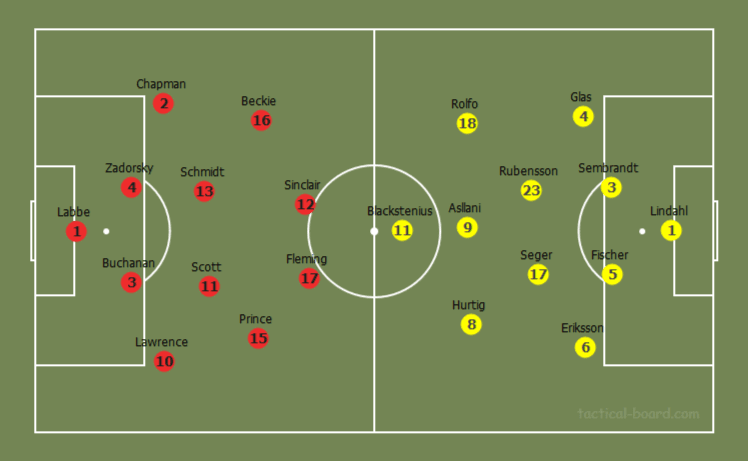
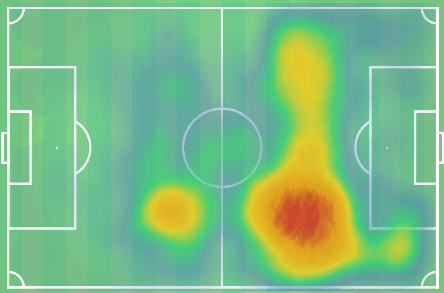
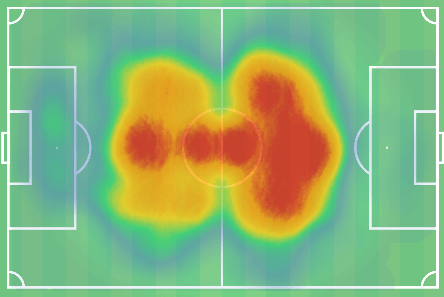
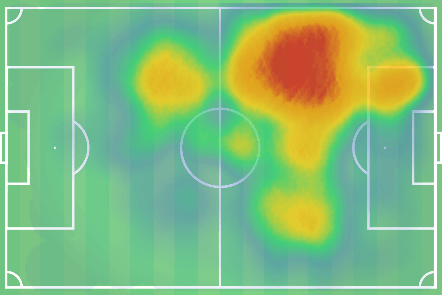
Attacking Midfield
Kevin De Bruyne’s torn knee ligaments in August 2018, along with other injury issues for the Belgian, and Bernardo Silva’s form on the right wing, led to Gündogan starting many matches in an attacking central midfield role, mainly alongside David Silva. Guardiola’s positional rotation and expressive freedom allows the central midfielders to become part of the front five, enabling them to roam around the pitch and interact with others, while the defensive five have a more rigid approach.
The table and charts below outline the offensive statistics of Gündoğan, the Silvas, De Bruyne and Foden when playing in either the left or right offensive central midfield position.
|
Player |
Goals |
Assists |
xG |
xA |
2nd Assists | Passes (Success %) | Passes into Box (Success %) | Dribbles (Success %) |
| Gündoğan | 0.28 | 0.28 | 0.2 | 0.22 | 0.28 | 59.15 (89.5) | 3.7 (62.4) | 1.77 (71.9) |
| De Bruyne | 0.31 | 0.36 | 0.2 | 0.4 | 0.1 | 60.73 (79.8) | 8.67 (58.2) | 3.93 (75.3) |
| D.Silva | 0.23 | 0.28 | 0.26 | 0.25 | 0.2 | 69.5 (87.6) | 5.21 (73.4) | 2.22 (88.8) |
| Foden | 0.51 | 0 | 0.43 | 0.2 | 0.09 | 51.43 (88.8) | 4.03 (72.3) | 3.26 (84.2) |
| B.Silva | 0.32 | 0.28 | 0.19 | 0.24 | 0.12 | 50.89 (87.8) | 4.03 (64.4) | 3.0 (72) |
Table: Average offensive metrics per game for Manchester City’s midfielders when playing in a central attacking midfield role.
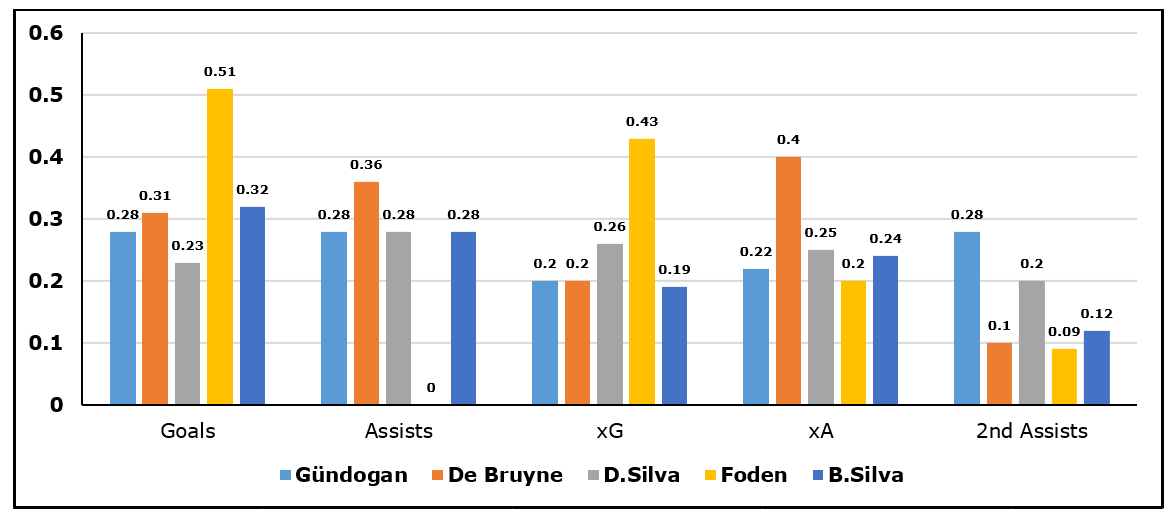
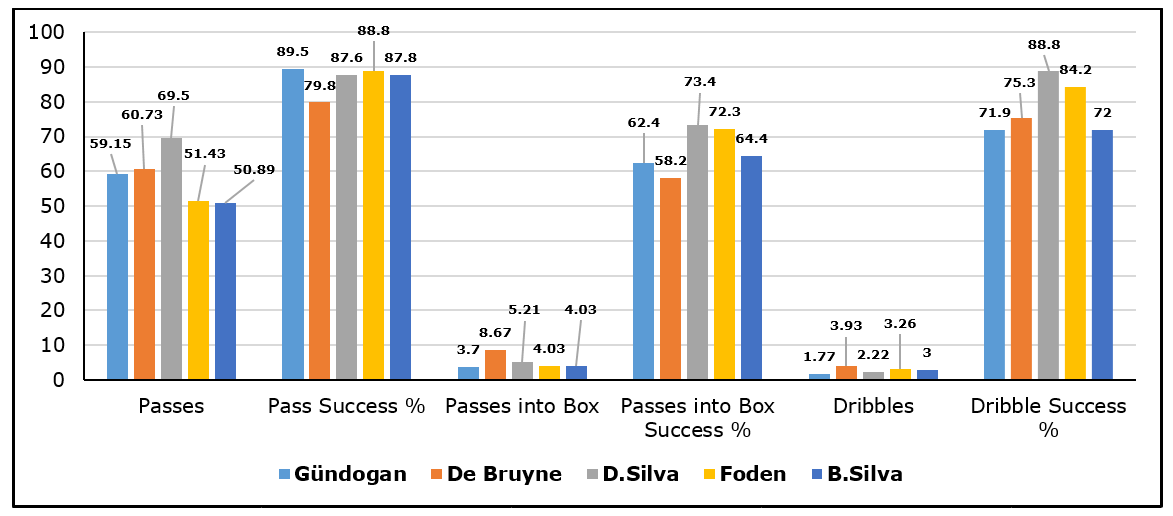
These statistics show that Gündoğan matches up well with the output of his City teammates. Overall, he does not look out of place when compared to players who would consider the attacking central midfield role their natural position, although you could argue Bernardo Silva is a more natural wide playmaker as opposed to a central midfield player.
The German ranks fourth for goals per game, joint second for assists per game and first for second assists per game. Second assists are an interesting stat when you consider City’s style of play, a Second assist potentially consists of a defence-splitting pass prior to a squared ball across goal, a key feature of Sterling and Sane’s play in recent seasons. Gündoğan is also ranked first for his pass success rate, however, it seems his teammates are superior in terms of playing successful balls into the penalty area and dribbling past opponents.
A key trait that the Citizen holds, that maybe isn’t portrayed in the stats, is his ability to make runs from midfield and arrive late in the box. The images below highlight a graphical representation of Gündoğan’s late runs and the impact it has on opposing defences. This is something which David Silva has mastered over the years.
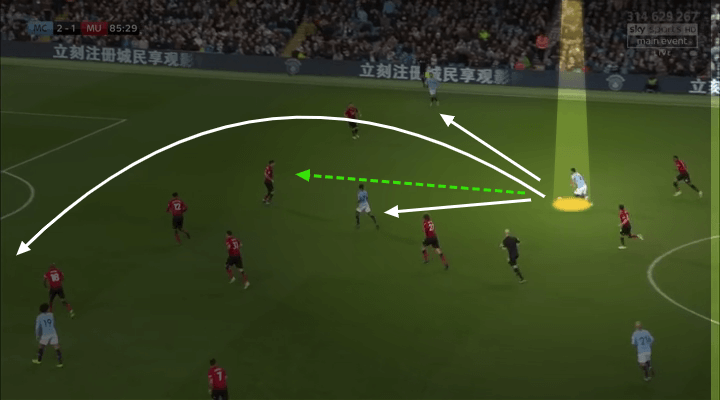
In the image above, Gündoğan finds himself in the RCM (Kevin De Bruyne ‘8’) position. He has four options: A simple pass to Bernardo Silva or Sterling, a more difficult pass through to Sane (who is positioned on Ashley Young’s blindside) or continue to drive at a retreating defence.
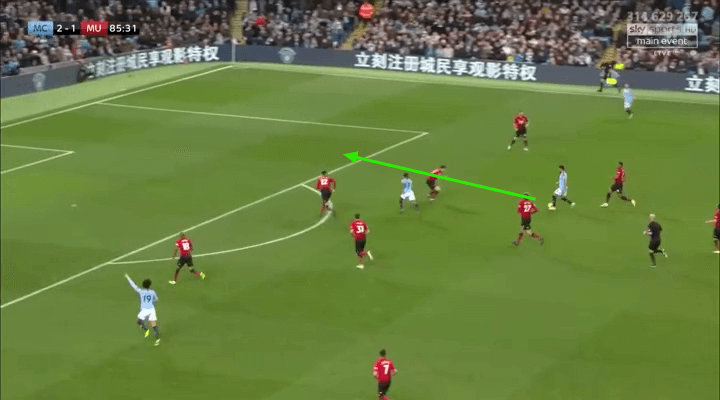
Gündoğan drives at the defence before slipping in Sterling, but, Gündoğan continues his run onto the shoulder of the CB. Sterling doesn’t shoot and the ball works its way out to Bernardo Silva on the right wing.
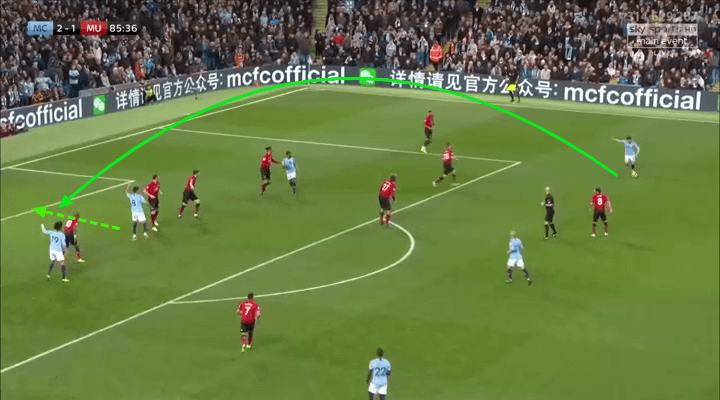
Gündoğan is in the box, on the shoulder of Matic and is ready to make a dart towards goal as the ball is played. The United defence should pick up Gündoğan better, but his drive and follow on run is unfamiliar when compared to a static striker’s position.
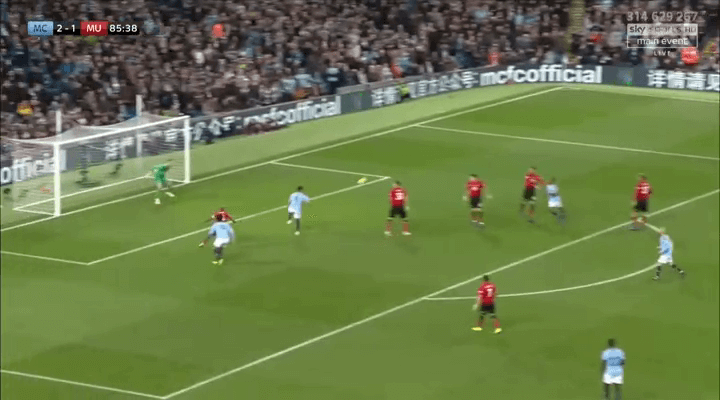
Gündoğan makes the run with the United backline unaware. A great cross and run leaves the advanced midfielder needing to take a touch and finish, which he does.
While Gündoğan looks right at home in terms of offensive statistics when in an advanced midfield role, the table and charts below outline how the attacking central midfield options at Manchester City perform in defensive metrics.
| Player | Ball Recoveries | Possession Losses | Interceptions | Defensive Duels (Success %) | Aerial Duels
(Success %) |
| Gündoğan | 4.64 | 7.96 | 3.04 | 5.31 (19.8) | 1.05 (31.6) |
| De Bruyne | 5.41 | 11.37 | 2.35 | 5.76 (26.5) | 1.33 (34.6) |
| D.Silva | 5.44 | 8.97 | 2.39 | 4.63 (19.1) | 1.44 (45.6) |
| Foden | 3.94 | 7.37 | 1.54 | 7.29 (16.5) | 1.71 (20) |
| B.Silva | 5.55 | 7.67 | 3.12 | 6.03 (22.5) | 1.32 (21.2) |
Table: Average defensive metrics per game for Manchester City’s midfielders when playing in a central attacking midfield role.
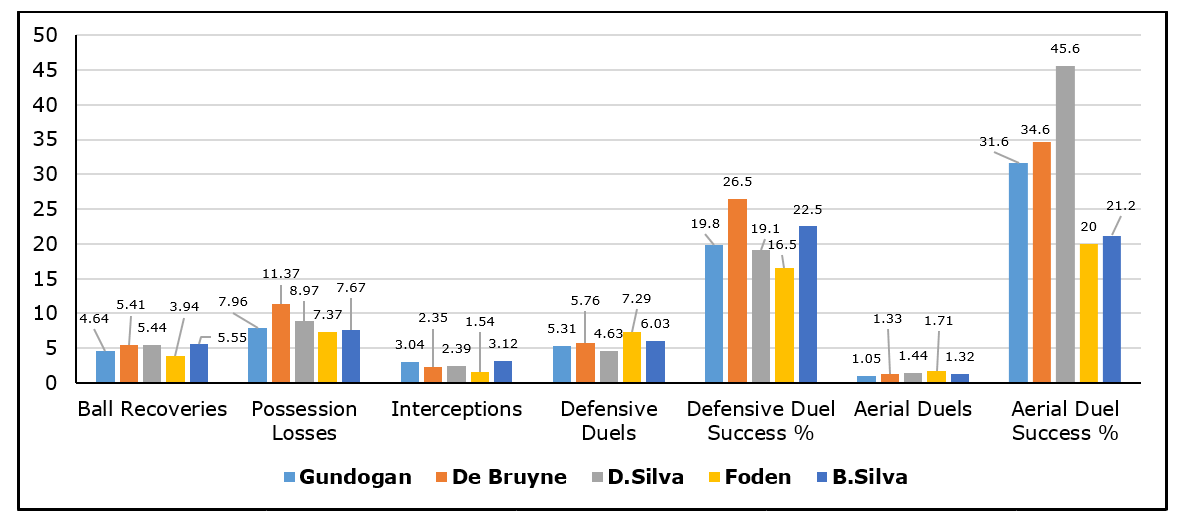
The stats suggest that the former Dortmund man and the other attacking central midfielders are once again fairly well matched, with no major outliers within the data. This is somewhat surprising, given the praise Gündoğan has received for his well-rounded game and experience in offensively and defensively weighted roles, it may be expected for the German international to excel in such defensive metrics.
While there are no major outliers, differences between players still occur. Gündoğan produces fewer ball recoveries than some of his teammates, but his ball retention is more impressive than the first choice players in David Silva and De Bruyne. A key metric to note is the number of interceptions, the versatile midfielder sits second in the ranking, with Bernardo Silva top, reinforcing recent media reflections on Bernardo Silva’s high work rate and intelligent pressing, tackling and interceptions.
Gündoğan is ranked higher than David Silva and De Bruyne for interceptions, highlighting his reading of the game, and while he may not produce the same kind of frantic looking pressing like Bernardo Silva, Gündoğan utilises his anticipation and experience to telegraph where the opposition will play the ball.
Examples of the German’s game intelligence are visualised below. Overall, Gündoğan’s ball retention and interceptions skills may add an extra element of solidity to the attacking midfield role in the absence of David Silva or De Bruyne.
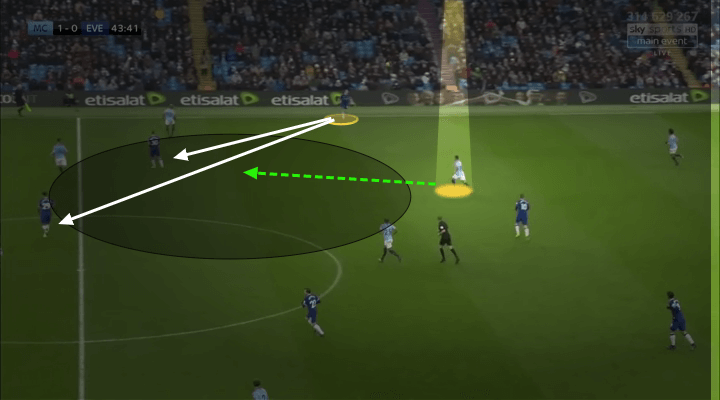
As you can see above, when the circled Everton player controls the ball, Gündoğan realises there is a large space in the middle of the pitch. He notices that he can move intelligently to cut off two potential passing lines.
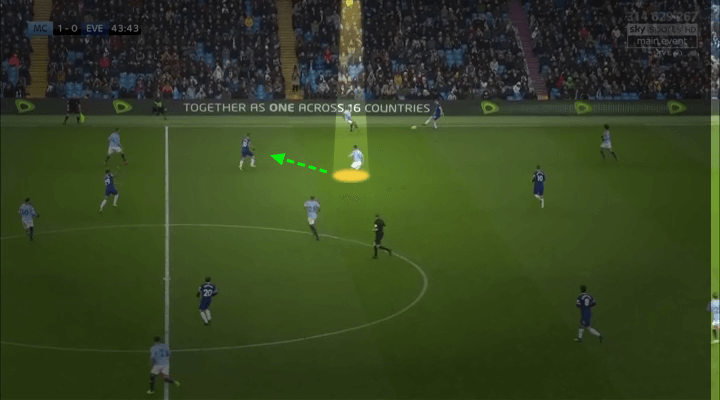
Gündoğan moves into the space to close the gap, as other City teammates do the same. He sees the move develop and can now see the direct pass the Everton player will make. He continues his movement to cut the pass out.
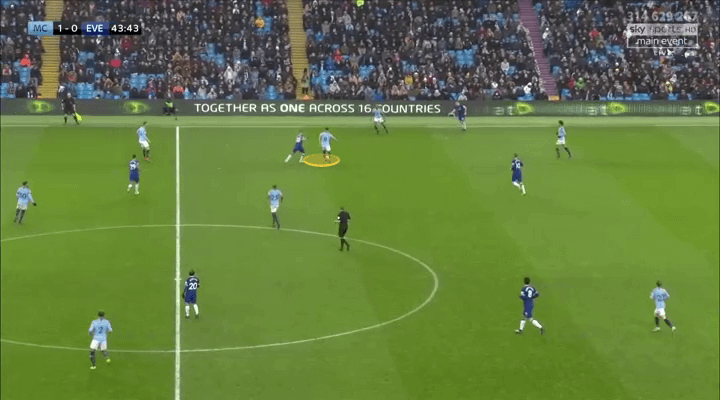
Gündoğan intercepts successfully and regains possession.
Defensive midfield
Despite him being 33, Fernandinho has rarely suffered an injury to keep him out of a run of matches for Manchester City. This occurred as the season run-in approached March, although, it felt like all season was a run in due to the pressure Liverpool put City under. Fernandinho’s injury gave Gündoğan an opportunity to play as City’s number ‘6’ in consecutive matches.
The sky blues’ difficulty performing without Fernandinho had already been noted after their Christmas defeats vs Crystal Palace and Leicester in the Premier League. City lost both games in the absence of Fernandinho. Gündoğan played in the defensive midfield role in the match against Leicester and did not operate as a stand out performer, however, multiple individual errors and a poor team performance cost City the match. In addition, the versatile midfielder hadn’t had the opportunity to settle into the number ‘6’ role the way he did after Fernandinho’s lengthy injury lay-off from late February onwards.
In terms of pitch coverage, Fernandinho and Gündoğan play the role in a somewhat similar manner, although, on average, Fernandinho drops deeper than Gündoğan. However, both players operate higher up the pitch in relation to comparative defensive midfielders, see the heat maps below, this is due to City’s ball dominance.
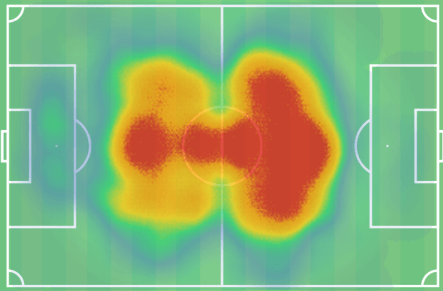
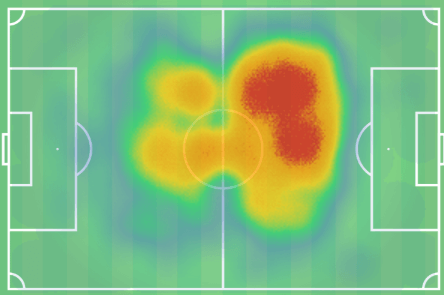
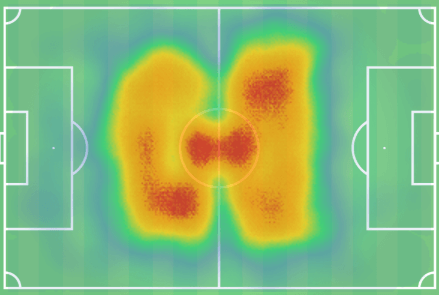
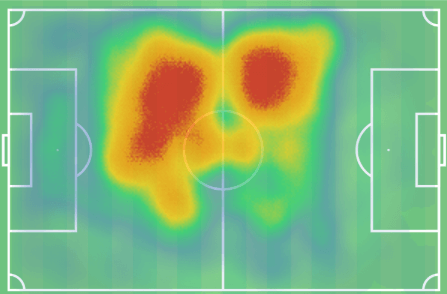
The defensive midfielder selected for City operates high but always stays behind the play to keep the ball moving, pick up cleared balls and break up arising counter attacks. While the overall responsibility of the role is presumed defensive in nature, Pep’s possession philosophy and quality of players means that the so-called defensive midfielder often finds themselves playing in the position of an attacking midfielder. Therefore, effective passing, creativity, vision, link up play and output via goals and assists can enhance the success of the role and player within the system.
The table and charts below show the average offensive stats of the two defensive midfield options for Manchester City, alongside other defensive midfield players from the top six Premier League teams.
|
Player |
Goals |
Assists |
xG |
xA |
2nd Assists | Passes (Success %) | Passes into Box (Success %) | Dribbles (Success %) |
| Gündoğan | 0.06 | 0.12 | 0.06 | 0.19 | 0.25 | 97.97 (92.2) | 5.44 (50) | 1.05 (82.4) |
| Fernandinho | 0.03 | 0.07 | 0.07 | 0.09 | 0.07 | 72.82 (89.4) | 3.72 (59.5) | 0.66 (65) |
| Fabinho | 0 | 0 | 0.01 | 0.03 | 0.11 | 59.4 (87.5) | 1.86 (52.9) | 0.6 (90.9) |
| Jorginho | 0.04 | 0 | 0.03 | 0.07 | 0.08 | 75.03 (89.3) | 2.9 (46.9) | 1.03 (75) |
| Matic | 0 | 0 | 0.02 | 0.02 | 0 | 56.8 (88.2) | 1.4 (65.6) | 1.36 (77.4) |
| Winks | 0 | 0 | 0.02 | 0.01 | 0 | 70.4 (93.6) | 0.41 (25) | 1.74 (70.6) |
| Dier | 0.15 | 0 | 0.07 | 0.02 | 0 | 55.11 (88.4) | 0.29 (50) | 0.58 (75) |
| Torreira | 0 | 0.06 | 0.01 | 0.02 | 0.17 | 61.78 (91) | 1.24 (68.2) | 1.07 (68.4) |
Table: Average offensive metrics per game for Gündoğan, Fernandinho and additional defensive or deep-lying midfielders from top six rivals.
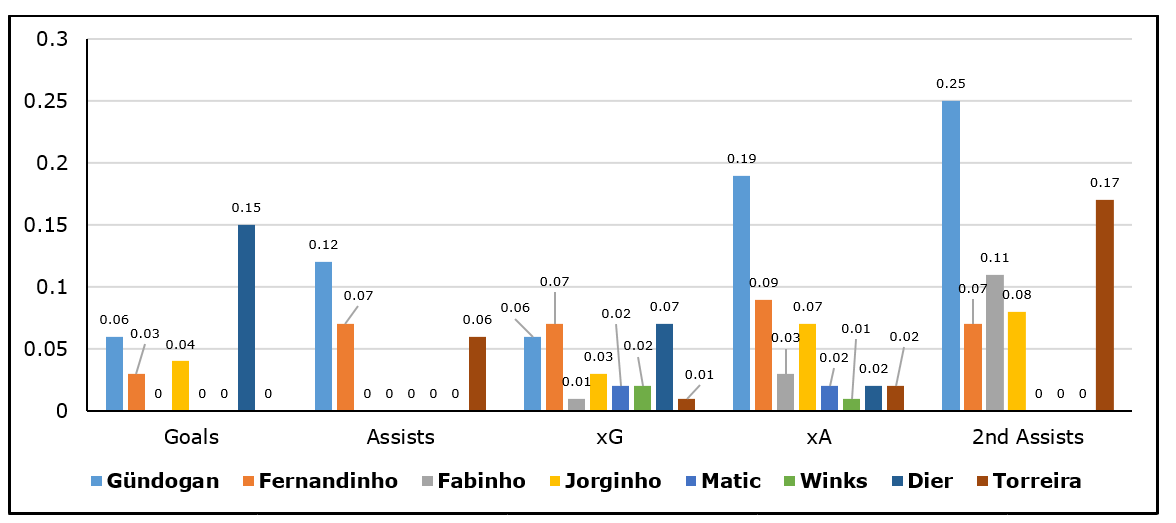
The statistics highlight that Gündoğan excels in the offensive elements of the defensive midfield role at Manchester City when compared to teammate Fernandinho, and other more specialised players in the number ‘6’ role.
The German produces a higher goal and assist rate, makes a higher number of passes with a higher accuracy rate and plays more passes into the penalty area than all compared players. Likewise, to the attacking central midfielder comparison, Gündoğan’s dribbling output is not as high as other players, but his dribbling success rate is ranked 2nd, suggesting that when he attempts to dribble, he is proficient. While Fernandinho’s defensive absence was feared, and rightly so based on results earlier in the season, Gündoğan’s introduction to the role appeared to add to City’s strengths in an offensive nature.
After delving into match footage of Gündoğan’s offensive skills when deployed in the defensive midfield position, a trend of how he uses his vision and passing ability to enhance team performance is evident. He frequently completes successful lobbed passes into an attacking runner within the box, while operating on the periphery of the box and acting as the midfield anchor. The core responsibility of the number ‘6’ role would usually be to pick up the cleared balls and disassemble opposition counter-attacks, with Guardiola, extra attacking responsibility is given. This tendency is supported by the statistic highlighting how Gündoğan plays more successful balls into the penalty area than Fernandinho and comparatives. Excelling in that performance metric is also likely to enhance Gündoğan’s assist and 2nd assist output, for which again he is ranked first amongst alternatives when playing in the number ‘6’ role.
The series of images below will outline the midfielders attacking ability when deployed in the number ‘6’ role.
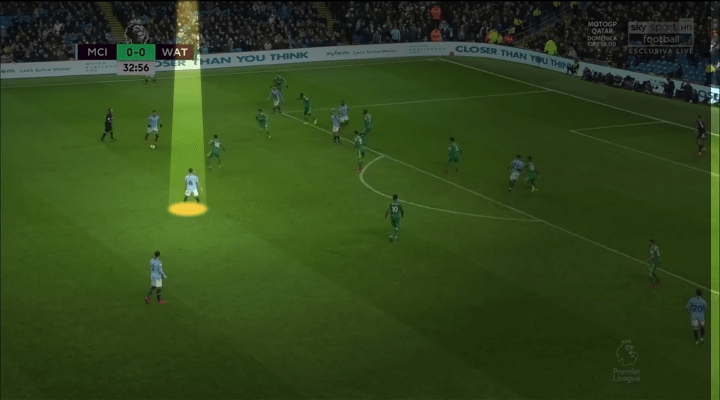
With Manchester City typically dominating the ball, Gündoğan is operating as the registered defensive midfielder, but playing in an advanced central position. His position allows him to receive the ball to keep attacks flowing, play passes to more advanced teammates and help disrupt any counter-attacking threats should City lose the ball.
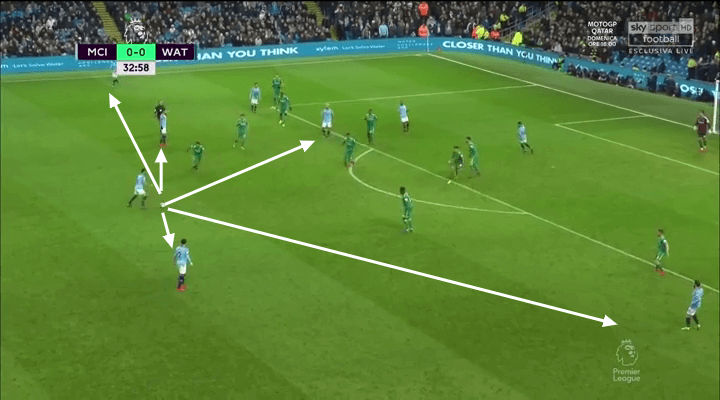
Gündoğan receives the ball, and, as per Manchester City’s build-up and interactions, he has many relatively simple ground pass options, although, neither would appear to create a shooting opportunity for a teammate.
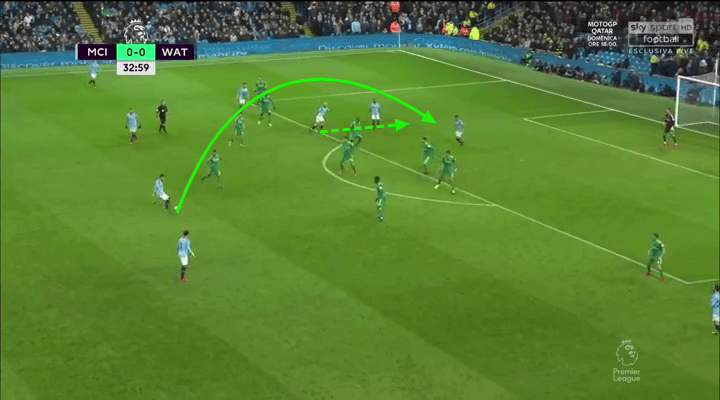
Gündoğan realises that the type of pass to hurt Watford and play a teammate into the 18-yard area behind their defence would be a delicately lobbed ball into a gambling attacker, in this instance, Sergio Agüero. To play a pass of this kind needs vision, technical ability, disguise to fool the opposition, timing and an intelligent link with teammates. Gündoğan and Agüero need to have the unspoken connection to determine that the pass can be played, how it needs to be played and when it needs to be played to match the defence-splitting run.
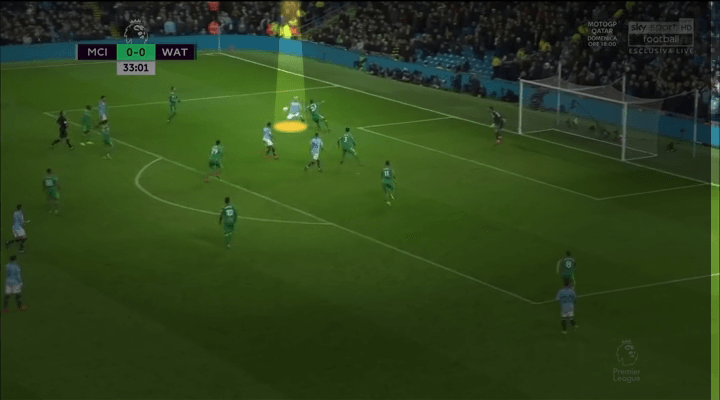
Gündoğan plays the pass to find the run of Agüero, who cannot hit the ball first time and so takes a touch inside the defender who tracked his run.
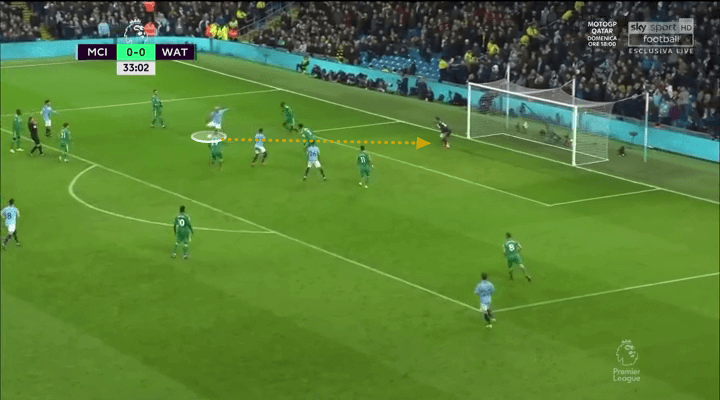
Agüero takes his touch inside and is able to work space to take a shot on goal. It is saved well by Ben Foster in the Watford goal. But, the purpose of this figure was to highlight the ability of Gündoğan, he is able to utilise his creative skills to aid Manchester City’s attacking prowess when playing a position that is, on paper, predominantly defensive. Gündoğan proves this by playing the Argentinian in behind the Watford defence from what appeared to be a relatively safe passage for Watford, with 10 defensive players between Gündoğan and the goal.
In a defensive sense, Fernandinho’s reported strength, the table and chart below utilise a comparison of defensive metrics for Gündoğan, Fernandinho and the same defensive midfielders from top six used in previous comparisons.
| Player | Ball Recoveries | Possession Losses | Interceptions | Defensive Duels (Success %) | Aerial Duels
(Success %) |
| Gündoğan | 9.45 | 6.77 | 3.73 | 4.2 (21.3) | 2.68 (47.1) |
| Fernandinho | 10.79 | 8.99 | 5.12 | 7 (30) | 5.36 (51.3) |
| Fabinho | 9.9 | 8.81 | 4.04 | 9.23 (23.6) | 3.68 (50.7) |
| Jorginho | 9.25 | 8.84 | 5.48 | 7.65 (23.7) | 0.97 (36.7) |
| Matic | 10.03 | 7.88 | 6.44 | 6.26 (20.3) | 3.28 (52) |
| Winks | 8.81 | 5.84 | 4.91 | 5.43 (24.5) | 1.33 (46.2) |
| Dier | 7.12 | 8 | 4.65 | 7.56 (11) | 2.67 (57.9) |
| Torreira | 10.54 | 9.03 | 5.6 | 6.56 (22) | 2.11 (22.9) |
Table: Average offensive metrics per game for Gündoğan, Fernandinho and other top six team defensive midfielders.
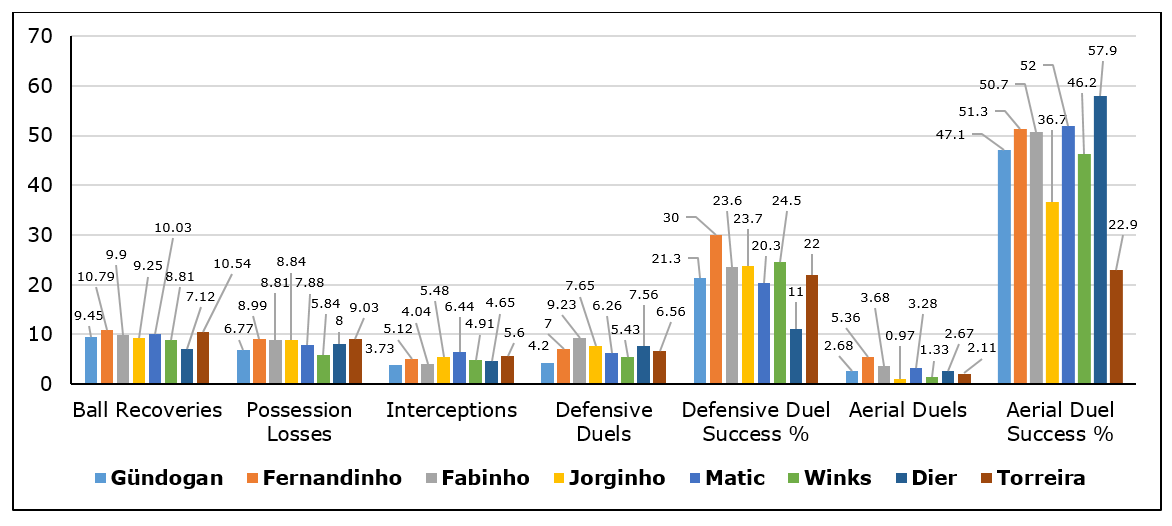
The statistics highlight that while the comparative players are specialists within the defensive midfield role in relation to the versatile German international, Gündoğan performs well in multiple areas, and is not outshone by many first choice number ‘6’s at rival Premier League clubs.
Gündoğan ranks 4fourth for ball recoveries, perhaps the most important metric for the ball winning midfield role, although he is ranked seventh for interceptions and number of defensive duels, and fifth for aerial duel success. The standout figure which reinforces Gündoğan’s contrasting style to many of his rivals, and his successful ball retention. In terms of the number of possession losses, Gündoğan is second to Harry Winks, a player who would also be deemed more of a ball playing holding midfielder rather than a ball winner, highlighting Gündoğan’s impressive skills when retaining possession for his team. Gündoğan utilises his passing ability, anticipation, awareness and positioning to offer himself as an option for teammates. Prior to receiving the ball, Gündoğan already knows the location of his next pass, a skill in combination with passing ability and the aforementioned traits which results in his excellent ball retention and passing statistics in numerous positions.
In comparison to his Manchester City alternative, the analysis isn’t to suggest that Fernandinho’s ball retention, passing ability or psychological traits are poor by any stretch, as Fernandinho’s excellent all-round game have solidified his position in the starting 11, but Gündoğan is a more natural player on the ball than Fernandinho, who’s ball-winning skills outweigh those of the fellow Premier League champion.
The benefit of utilising such an effective ballplayer within the deepest midfield role at Manchester City is that the player can help Pep Guardiola’s team to dominate possession and keep the ball moving, in the hope of drawing the opposition out to press and exploiting the out of shape opposition.
Multiple examples of Gündoğan’s ability on the ball can be seen via match action, but, a specific example can be seen below.
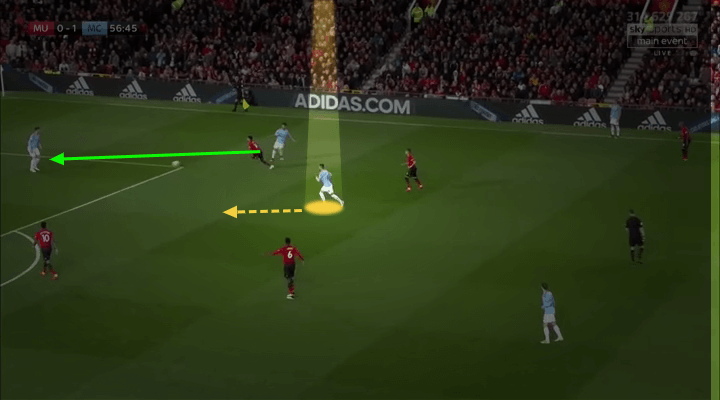
With the ball being passed back to Laporte and Manchester United pressing, Gündoğan moves into space to make himself available to receive the ball between the United press, making him a viable option for a pass from Laporte.
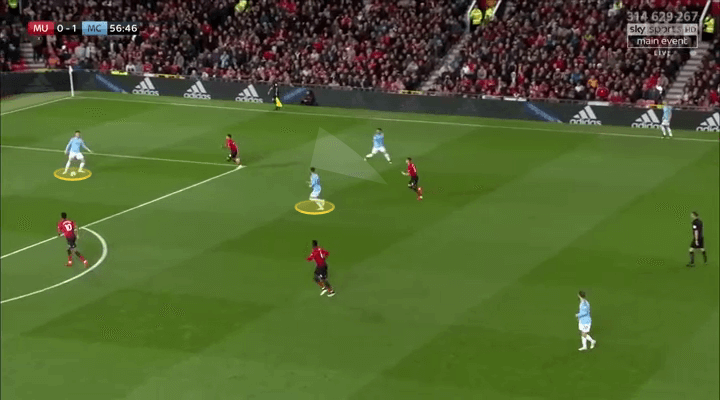
As Gündoğan enters the space, he is scanning to his right and identifies a teammate he could play the ball to if he receives the ball from Laporte, successfully planning ahead of the game.
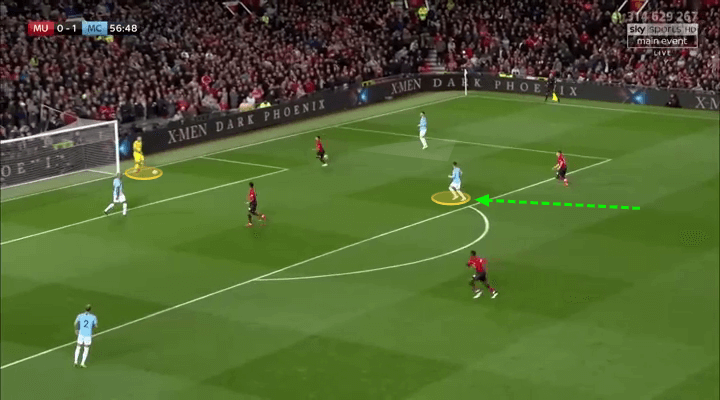
The ball is set back to Ederson, however, Gündoğan continues his movement between the United press and continues to make himself available to receive the ball. Again, he is scanning his options should he receive the ball and identifies Laporte as an effective option. Once again, he is using his game intelligence to stay one step ahead of play.
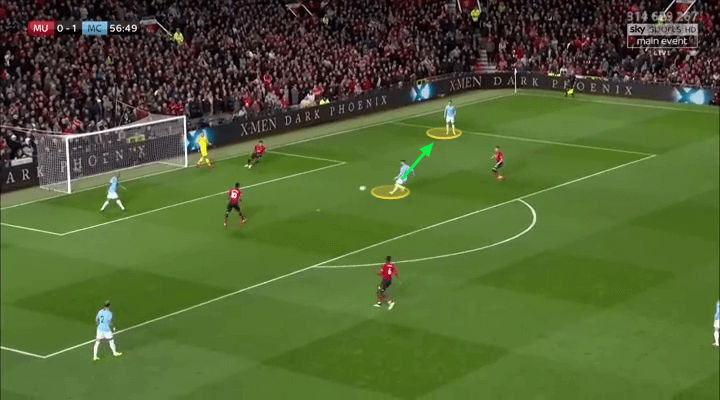
Gündoğan receives the ball from Ederson, and, as pre-planned, plays the ball first time to Laporte. As the United press advanced onto Ederson, and then Gündoğan, Laporte now has increased freedom.
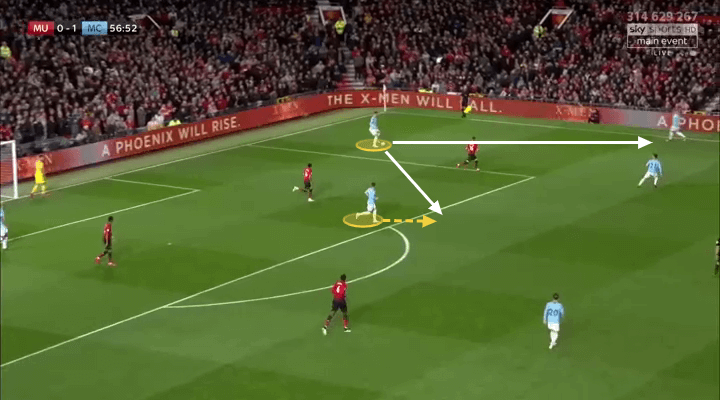
When Gündoğan plays the ball to Laporte, his involvement in the phase of play is not over, he switches his movement away from his own goal and begins to advance up the pitch, again this offers Laporte a passing option between the United press. With Zinchenko available on the left touchline, Laporte and City now have multiple options to play. Such options make it more difficult for United to predict the passing network and allows City to bypass multiple opposition players before advancing in an attacking sense.
Conclusion
Gündoğan has proved his versatility and reliability to step up to whatever role is asked of him within the team. The German can effectively step into an attacking central midfield position when needed and produce similar attacking outputs in comparison to first-choice teammates, while also adding the skill and experience of playing deeper midfield roles.
Gündogan can also act as a worthy alternative for Fernandinho, a player who many feel is possibly irreplaceable. The versatile midfielder does not excel when compared against Fernandinho and other top six alternatives in a solely defensive sense, but, he contributes defensively and adds an extra offensive dimension. As stated, such offensive proficiency may benefit Manchester City in certain situations given their attacking style of play. Gündoğan highlighted this during City’s winning streak towards the end of the season. Winning 14 Premier League matches in a row was not solely down to Gündoğan, as many factors formed an interaction for success, however, the midfielder proved he is more than capable of adopting the defensive midfield role and providing a midfield base for more advanced players to build on.
Overall, based on his versatility and playing ability, the midfielder has proved he is of high importance to Manchester City. With Gündoğan’s contract expiring in 2020, it may be as or more important for Manchester City to tie the versatile German down to a new contract, rather than looking away from the club for more midfield reinforcements.
If you love tactical analysis, then you’ll love the digital magazines from totalfootballanalysis.com – a guaranteed 100+ pages of pure tactical analysis covering topics from the Premier League, Serie A, La Liga, Bundesliga and many, many more. Buy your copy of the May issue for just ₤4.99 here, or even better sign up for a ₤50 annual membership (12 monthly issues plus the annual review) right here.






Comments